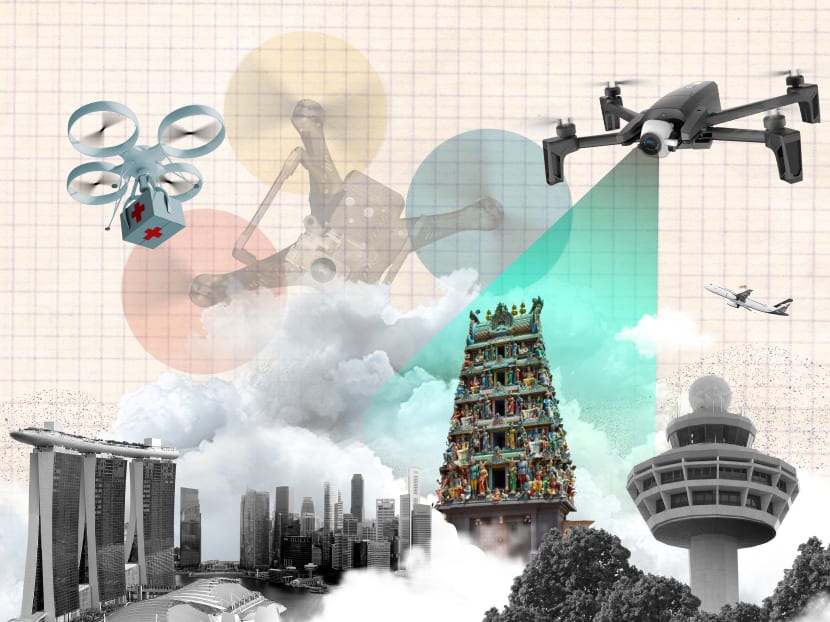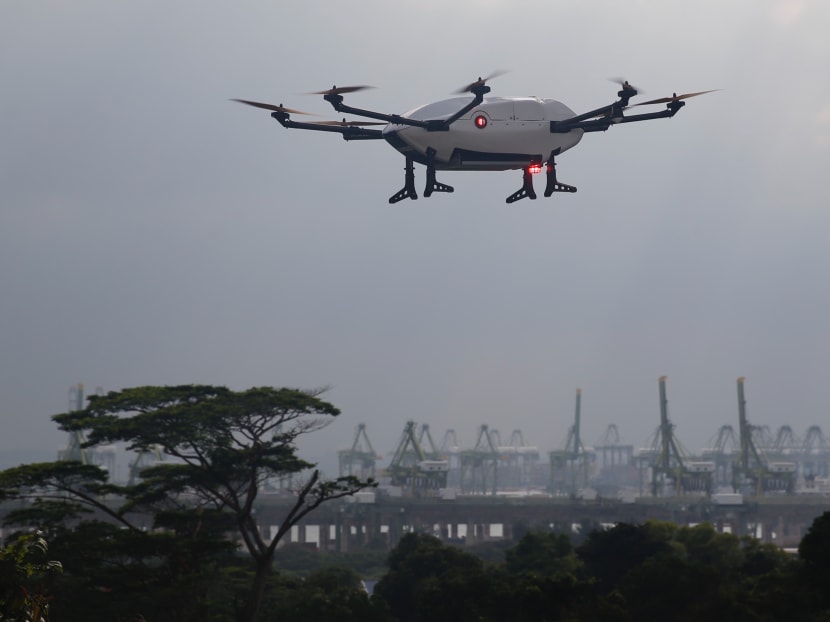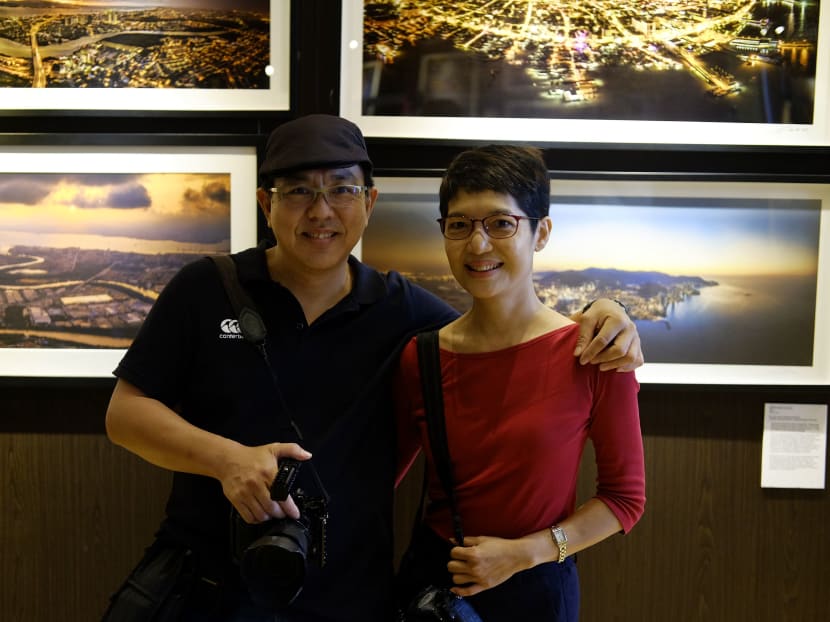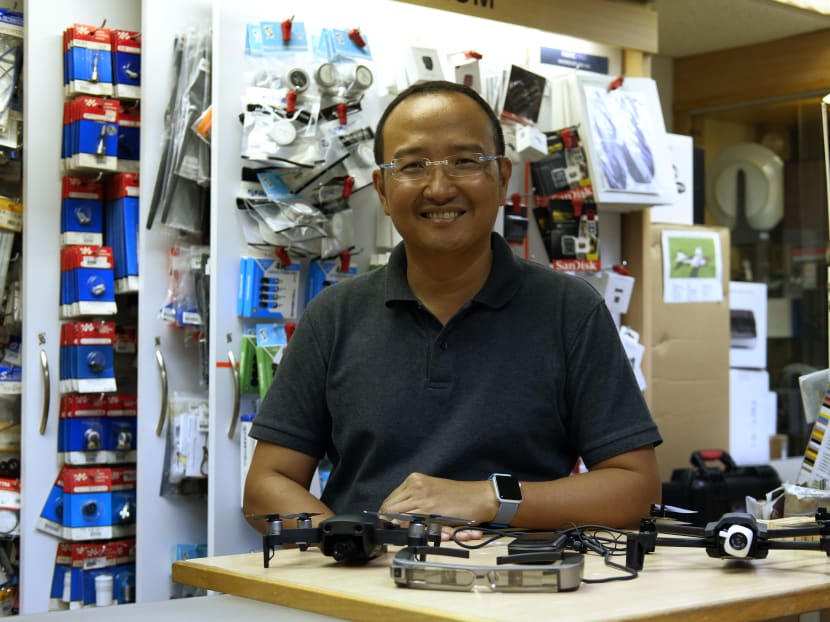The Big Read: Rise of the drones — capable of good and evil, they pose a regulatory dilemma
SINGAPORE — In the United States, drones fitted with thermal imaging cameras can be deployed to help firefighters search for survivors in a burning building.

Here in Singapore, drones are being used for various purposes — ranging from documenting the country’s heritage and history and mapping out golf courses, to scouring rollercoasters in the dark for abnormalities.
SINGAPORE — In the United States, drones fitted with thermal imaging cameras can be deployed to help firefighters search for survivors in a burning building.
Over in Rwanda, American firm Zipline has, since 2016, been using drones to deliver medicine to inaccessible places at a relatively low cost.
Here in Singapore, drones are being used for various purposes — ranging from documenting the country’s heritage and history and mapping out golf courses, to scouring rollercoasters in the dark for abnormalities. Other potential uses include parcel delivery, as well as inspections of buildings, trees, ships and sewage tunnels, for example.
But like a double-edged sword, the drones’ niftiness and ease of operation also lend themselves to nefarious uses.
Mexican drug cartels have replaced human mules with quadcopters — dubbed by the US media as narco-drones — to smuggle contraband across the US border.
The terrorist group Islamic State of Iraq and Syria (ISIS) had reportedly used over-the-counter drones to drop grenades on its enemies in Syria.
Lately, drones have also gained infamy for causing air traffic disruption. In Britain last December, a drone sighted at London’s Gatwick Airport caused a three-day disruption to the country’s second-busiest airport.
Singapore’s Changi Airport has not been spared either, with two separate incidents of drone incursions occurring within a week recently.
As a result, a total of 37 flights at Changi Airport were delayed on June 18 and 19, while another arriving flight was diverted to Kuala Lumpur.
On June 24, about 15 departures and three arrivals were delayed, while seven other flights were diverted, owing to bad weather and unauthorised drone activity. Investigations are ongoing.
The flying of drones without a permit is banned in Singapore if they are flown within 5km of airports or military airbases, or at altitudes above 61m.
Offenders could face a fine of up to S$20,000 or a jail term of up to 12 months, or both.
In May, the Civil Aviation Authority of Singapore’s (CAAS) set up an Unmanned Aircraft Systems Advisory Panel (UASAP) to review the regulatory framework for Unmanned Aircraft Systems (UAS). The panel is expected to provide its recommendations by early next year.
Nevertheless, following the Changi Airport intrusions, the Government announced during a parliamentary session on July 8 that it would introduce a mandatory registration regime for all drones in the Republic.

Larger, more capable drones will have to be licensed while stiffer penalties for errant drone users are also being considered, said Senior Minister of State for Transport Lam Pin Min.
Despite the threats that these devices could potentially pose, experts interviewed by TODAY were quick to stress that an outright ban on drones is neither feasible nor ideal.
“The bad guys, they don’t care about bans. If they want to do something bad, they can easily do it,” said Dr James Wang, a professor with the Nanyang Technological University’s School of Mechanical & Aerospace Engineering. “Anything can be used as a weapon. Bicycles, cars, motorcycles. Why not ban those too?”
Dr Daniel He, president of the Multirotor Association of Singapore, said that attempting to ban any technology the moment it runs into difficulties is a “sure way for Singapore to fall behind and kill off any innovation and progress that we hope to achieve”.
The medical doctor, who sits on UASAP, added: “Drones are a fascinating amalgam of engineering, electronics, and programming, all the skills that we desperately want the next generation of Singaporeans to acquire.”
Agreeing, fellow UASAP member, Associate Professor Foong Shaohui, said he foresees that the use of drones for industrial and commercial applications “will steady gain traction in the near future”.
This creates a potential source of new jobs, said Dr Foong, who is from the Engineering Product Development pillar at the Singapore University of Technology and Design (SUTD).
RECENT ADVANCEMENTS
The concept of using unmanned aerial vehicles (UAVs) to drop a payload over a location is not new in itself. The US’ Central Intelligence Agency (CIA) had been using armed drones as part of its war against the Taliban in Afghanistan since 2001.
Drones had predominantly been considered a military asset up until 2010, when the first ready-to-fly drone hit the shelves with the release of the AR Drone by French company Parrot.
While bulky, and with a limited flight time of around 12 minutes per battery, they were still a hit with consumers.
Unlike remote-controlled model helicopters, which have been around since the 1970s and require months to learn how to fly them decently, operating a drone is simple.
“Almost anyone can buy a quadcopter drone and within five minutes, you’ll be able to fly it. No problem. Even your grandmother could fly it,” said Dr Wang, who is also the director of the eVTOL (electric vertical takeoff and landing) Research and Innovation Centre.
He added that the last five years had also seen improvements in electronics and a reduction in the cost of drone components.
All of these factors have come together to make the drone accessible to the masses, and this consumer focus has led, in turn, to rapid advancements in drone technology.
Not only have the drones gotten small enough to fit in the palm of one’s hands, they can also be modified to suit certain tasks.
Said Dr Foong: “We have flown specialised drones at many of Singapore’s historical landmarks, such as Sri Mariamman Temple, Shuang Lin Monastery and Bukit Timah Railway Station, to create highly detailed and annotated three-dimensional models which can be digitally reproduced so that they can be preserved for future generations of Singaporeans.”
Dr Foong is also the principal investigator for a government-funded research project to design and develop a UAV to perform autonomous inspection of the deep tunnel sewerage system.
SUTD has also designed a prototype drone for the National Parks Board (NParks) specifically for inspecting trees.
The Tree Inspection Microdrone assists in aerial tree inspection, which traditionally requires a trained arborist to ascend the tree using ropes or using a mobile elevated work platform.
NParks says that apart from drastically reducing the amount of time required to inspect a tree – from a full day to half an hour – it is also able to gather “valuable images and videos” from perspectives which would have not been possible without a trained arborist physically climbing the tree.
S'PORE'S TIGHT AIRSPACE
Being a small country, airspace in Singapore is limited to begin with.
Nevertheless, as the authorities consider tightening the rules further, some drone operators and experts told TODAY that the existing framework is already making it tough for operators to pilot their UAVs without unintentionally running afoul of the laws.
If one were to just look at the CAAS’ map of areas that are off-limits to drone operators, it would look like there is still a decent-sized space in the central part of Singapore to fly the drones.
That is not the case, however, said drone hobbyist Farhan Tahir, who is also the administrator of the Facebook hobby group, Universal Drones – Singapore (UDS).
“There’s another layer (that operators need to be aware of) that comes from NParks,” said Mr Tahir.
Aside from the nature reserves, the production house owner said that a lot of recreational parks under the statutory board carry “no-drone” signs.

Responding to TODAY’s queries, NPark’s group director of corporate strategy and planning, Ms Sophianne Araib, said that the flying of drones and use of remote-control flying devices are allowed in most parks in Singapore except for those areas which are designated as No Flying zones by signs.
These areas, she said, include the nature reserves, nature parks and the Singapore Botanic Gardens as they are rich in biodiversity. “The use of drones could negatively impact biodiversity such as birds, as bird strikes could happen. Some of these areas are also rich in historical significance and contain conservation structures that need to be protected”.
Other locations, said Mr Tahir, belong to private property owners who are free to stop operators from flying drones over their property.
Sentosa is one such location which requires operators to apply for an activity permit if they wish to fly there.
“This really gives us less spaces where we can fly,” he said.
While the space outdoors is limited, indoor facilities, such as the sports halls at SUTD, may provide a safe space for beginner drone operators and researchers to pilot their UAVs, but they are far from ideal.
Dr Foong said it would be similar to someone learning how to drive within a circuit. But just like a circuit, it will not expose the operator to real flying conditions.
“You can’t fly fast, and you can’t fly high. It is just hard to find a big enough space in land-scarce Singapore.”
For Malaysian photojournalist David Loh, nothing would make him happier than being able to photograph Singapore in a light that few had seen before.
After all, the 51-year-old had called the city home for more than 20 years before he returned to his hometown of Penang in 2017, where he embarked on a mission to promote the north-western Malaysian state through drone photography.
Mr Loh’s work has culminated in an exhibition titled Over Penang + Beyond, and his photographs are currently on display at the Fullerton Hotel Singapore till the end of July.

He credits the drone for allowing him to capture the state’s stunning and evocative images. “People were shocked when they saw the photos and never knew these places existed. Even the chief minister (of Penang) was awestruck and didn’t realise how beautiful the island is.”
Mr Loh lamented that Singapore’s strict rules on drone use have made it unconducive for him to attempt something similar here.
“In Singapore, there are too many restrictions. I cannot be applying two weeks in advance to tell (the CAAS) I want to pay to shoot in this particular location. If it rains, then I have to apply and pay again,” said the former editor-in-charge of the Reuters news agency’s photo desk.
ENHANCING USER ACCOUNTABILITY
With these tiny aircraft changing the aviation landscape, existing laws related to drones are being revised or new ones introduced in many countries, including Singapore.
Dr Paw Yew Chai, an associate professor from the Engineering Cluster at the Singapore Institute of Technology (SIT), said that the European Union Aviation Safety Agency (EASA) and the Federal Aviation Administration (FAA) are putting in more drone laws in Europe and the US respectively.
“How effective and comprehensive these laws are is still not obvious,” said Dr Paw, whose research interests includes various aspects of UAV engineering and testing.
In June this year, the EASA published a set of common rules for the use of drones across the European borders without operators having to worry about differences in regulations.
Starting from June 2020, the common rules will replace national regulations that may have already been implemented by individual European Union countries.
The main rules include requiring operators to register themselves before they start flying their drones.
In the US, the FAA also mandates that all operators register any drones that weigh between 249g and 25kg.
Dr Paw said the registration of drones can help operators become more responsible. It might mean that only certain approved drones with safety features such as geo-fencing can be registered, he added.
“This helps to control the type of drone that can be flown in Singapore, and with the geo-fencing feature, it will prevent the drone from flying into the restricted areas.”
Registration provides tracking and identification of the drone and drone users, he reiterated. “This creates user accountability and facilitates law enforcement efforts,” he said.
Agreeing, Dr Wang added: “You just have to put your registration number on the drone and if it crashes, or flies somewhere it shouldn’t be and gets tracked down, at least we know who the owner is.”
Dr Wang acknowledged that this would not prevent bad hats from committing malicious acts.
This is where anti-drone technologies can come in, said Dr He.
However, as the technologies are relatively new, experts had previously told TODAY that it is far easier to cause disruptions than to prevent them.
Dr He believes that it will take time for organisations like the air force and airports to learn how to operate an “integrated and multi-layered solution” to tackle drone incursions into restricted airspace.
“I think that when fully operational, these (regulations) will be adequate to control most drones, with the exception of (cases involving) sophisticated state actors with multiple drone swarms. However, if we do encounter such an attack, I think we have a lot of bigger problems to worry about than drone regulations.”
MULTI-PRONG APPROACH NEEDED
While Mr Tahir agrees that there should be some form of regulations to ensure the skies are safe, he cautions against making them too onerous.
“This will just turn away new hobbyists, or even the current ones. These people might have the potential to (produce) the next (big) thing in drone (technology)…by helping to develop digital technologies even further.”
Hobby shop owner Ronald Yong added that if drone operations are going to become part of future careers, it does not make sense to overly limit them.
The general manager of Singapore Hobby Supplies, which he describes as a one-stop shop for drone enthusiasts, said the public at large needs to focus less on the negative aspects of drone technology.
“People should be informed of the good uses of drones as well. They can have applications that will one day make a difference in your life,” said the 44-year-old.

Dr Foong said that at SUTD, drones are used to facilitate the teaching of design innovation, physics concepts and rapid prototyping.
SUTD regularly holds design workshops where students get to design, build and fly a drone from scratch during a three-day course.
“It allows these students to understand how physics theories learnt in the classroom can be used to design and operate drones. They will also learn about rapid prototyping, programming and basic flight theory,” said Dr Foong.
Dr He felt that the dilemma of drone use should be addressed with a hard-nosed approach, driven by data in analysing the risks and benefits.
“I would venture that the greater challenge is how to encourage and nurture drone use while making it as safe as possible," he said. “I think that first and foremost, we need to have a system of education to teach people what is safe behaviour."
On his part, Mr Yong has been ensuring that customers who buy drones from him are adequately aware of Singapore’s laws by sticking informative labels on his boxes and telling them where they can or cannot fly their aircraft.
However, more can be done. Dr Foong said more prominent signage could be installed around the island to ensure that inexperienced operators are well aware of where their drones cannot fly.
A website that clearly shows where all the no-fly areas are, according to different agencies, would also be useful, he said.
Dr He also suggested having a tiered registration and licensing scheme that is proportionate to the size and capabilities of the class of drones that people want to operate.
“On the one hand, you would not let anyone drive a lorry with no licence plate and no driving licence. On the other hand, you wouldn't demand that a child register and take a licence for a remote control car. I think a similar approach should be applied to drone regulations.”
Dr He added that there should be regular and effective enforcement, as well as penalties for errant behavior.
Just as certain neighbourhoods have skate parks, Dr Wang believes that the authorities could also open up more air space by designating certain areas as drone parks.
These places, which could be near the homes of the operators, provide a safe zone for them to fly their drones without any worries of breaking the law.
Ultimately, the solution would have to be multi-pronged — encompassing a strong educational and regulatory framework, said Dr He.
He added: “(We need) to create safe spaces of sufficient size for people to practise and experiment; engage young people and create interest through drone programmes and sports.”








